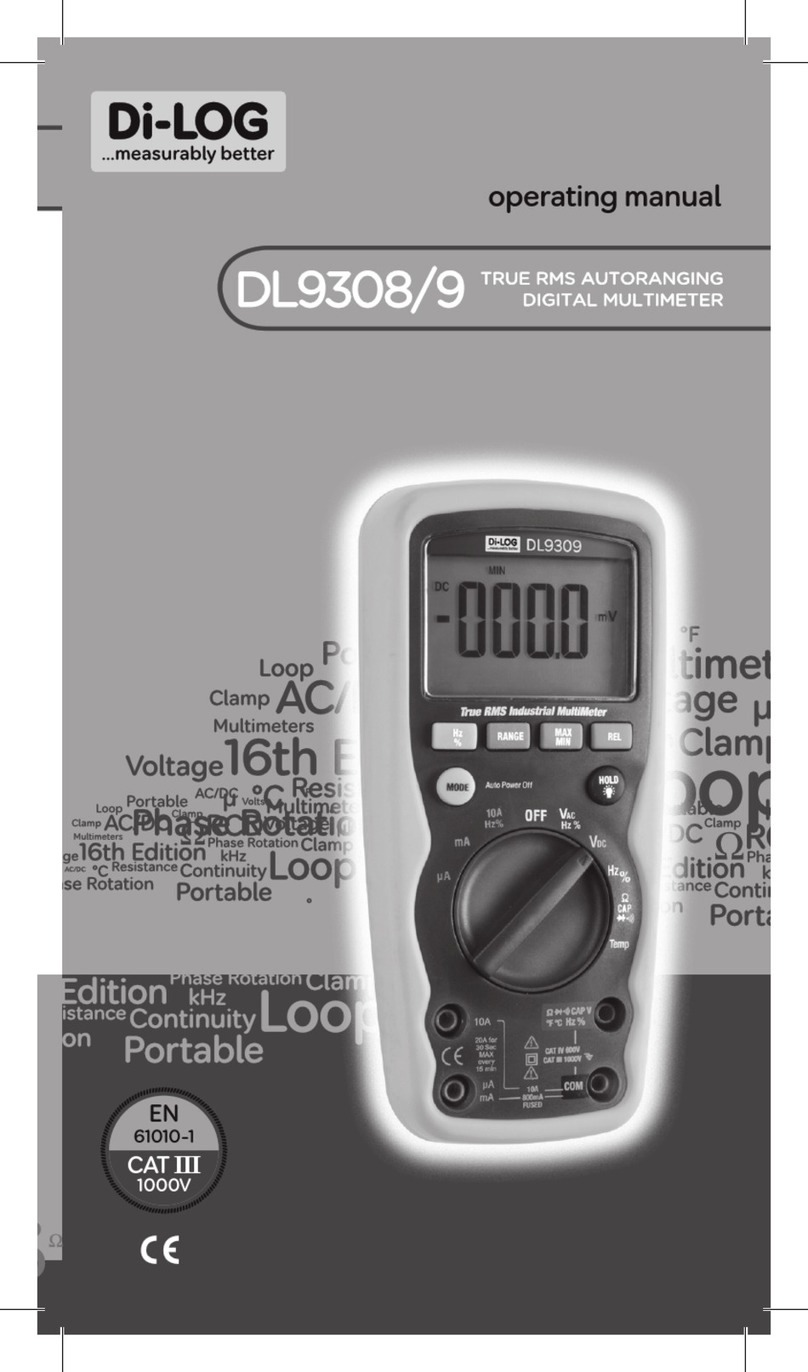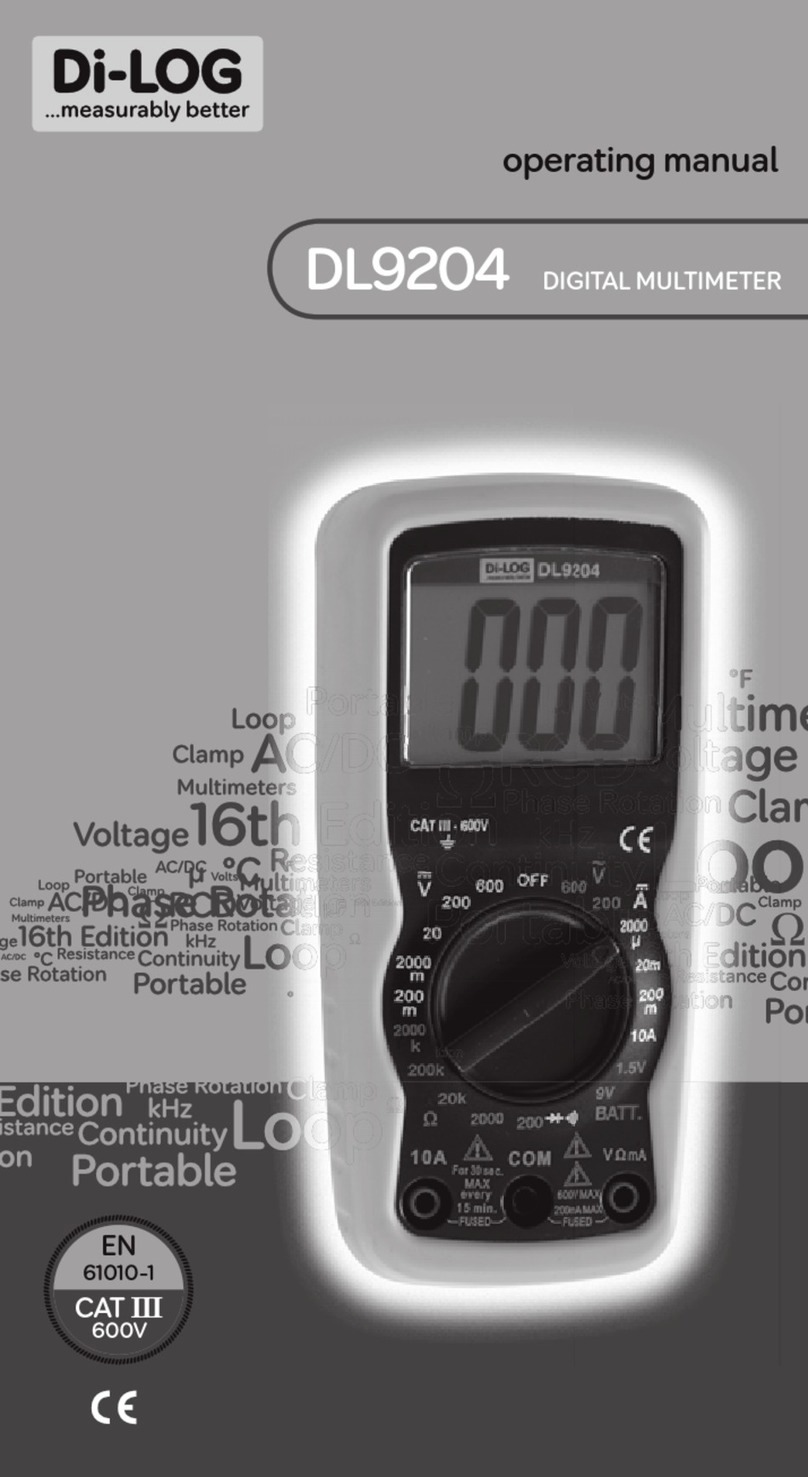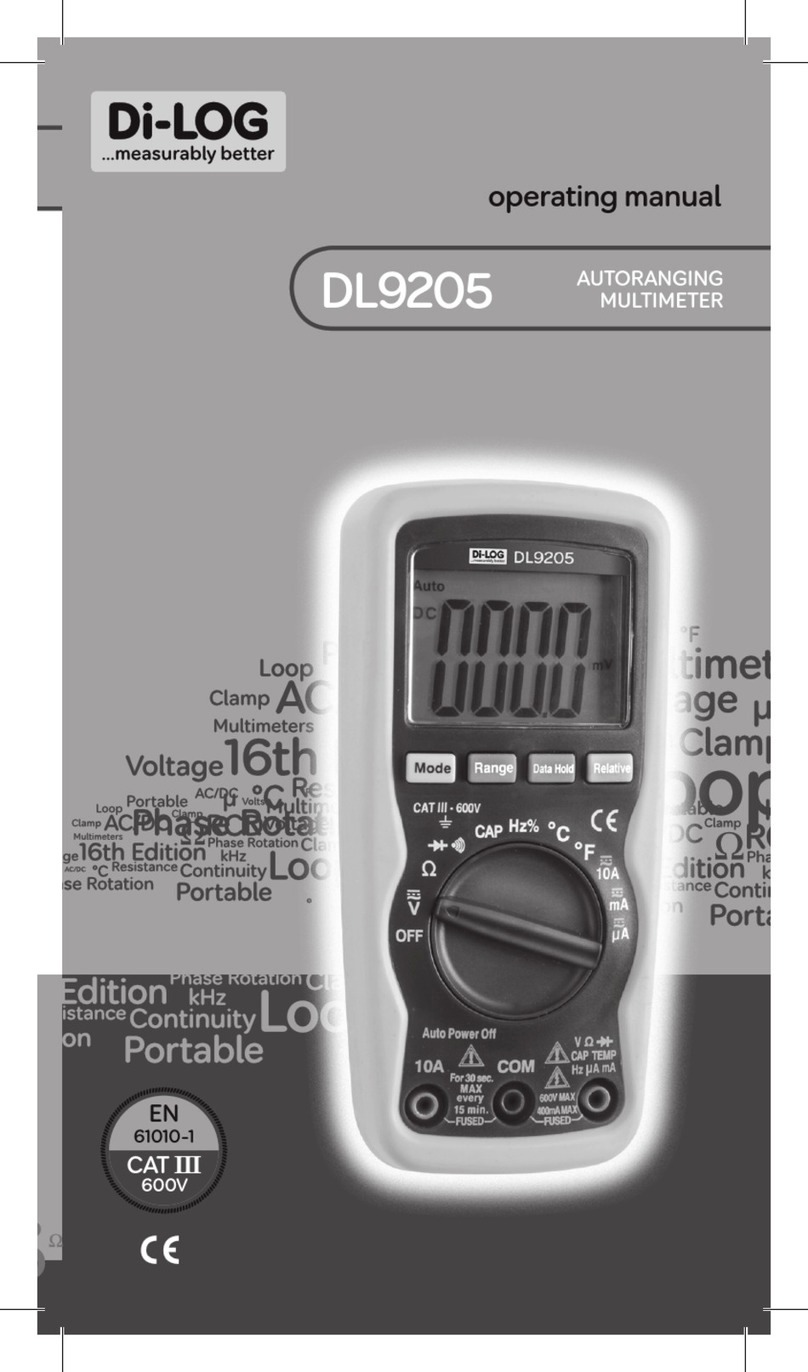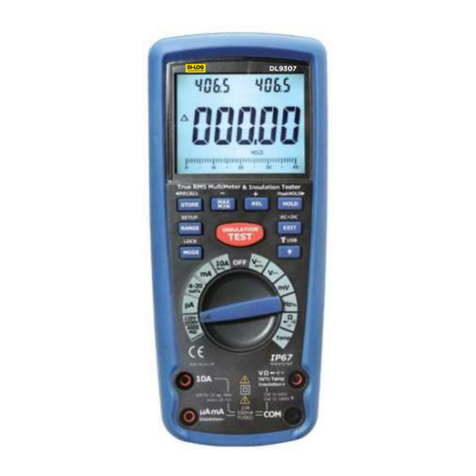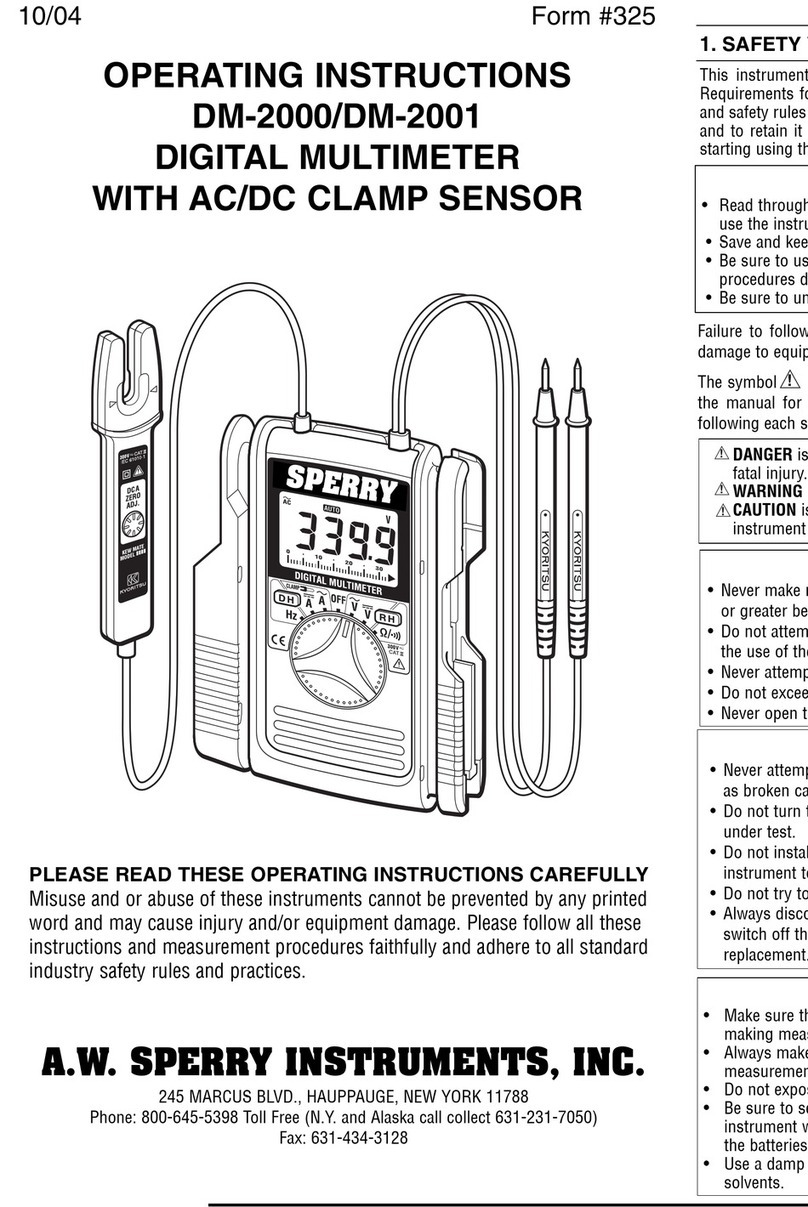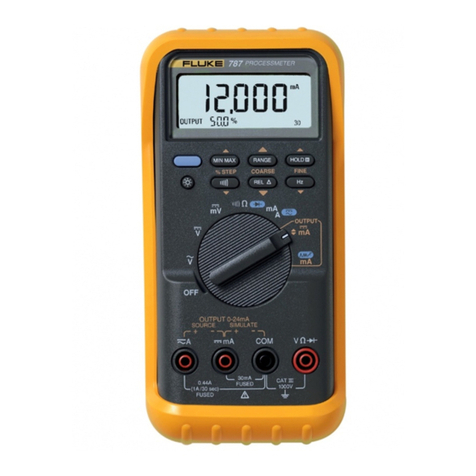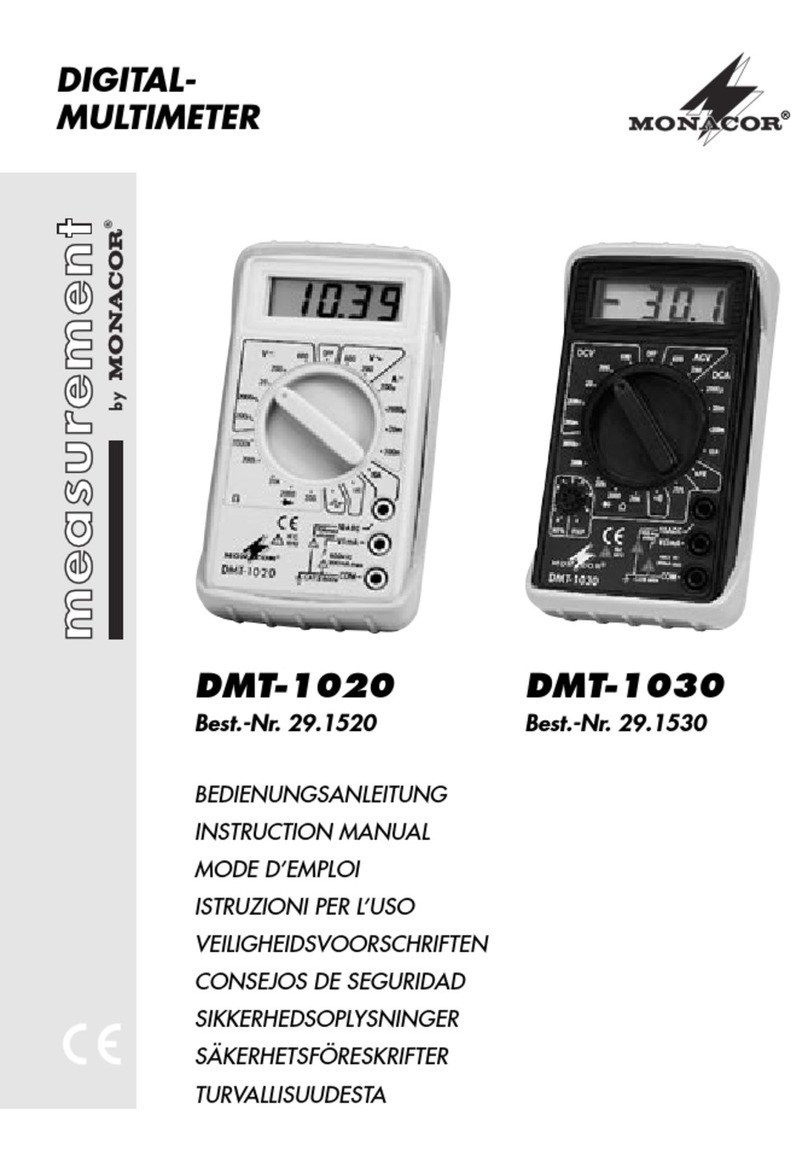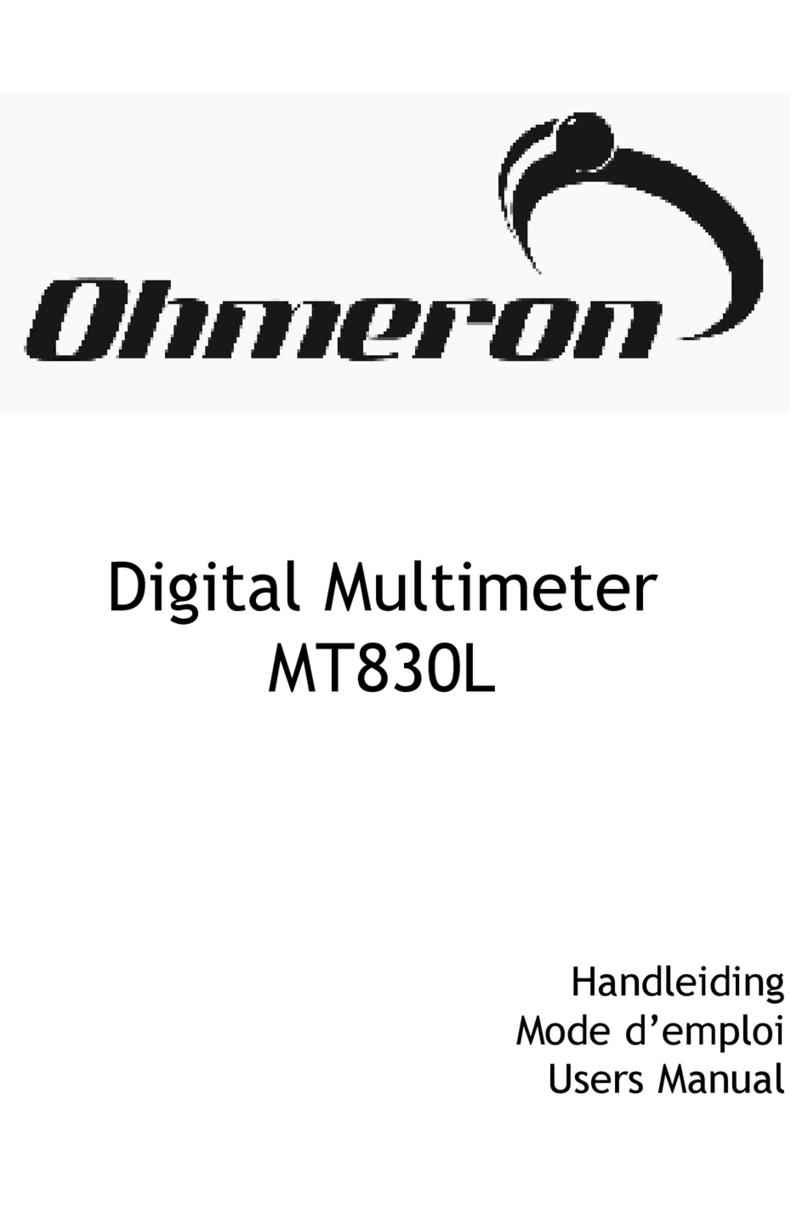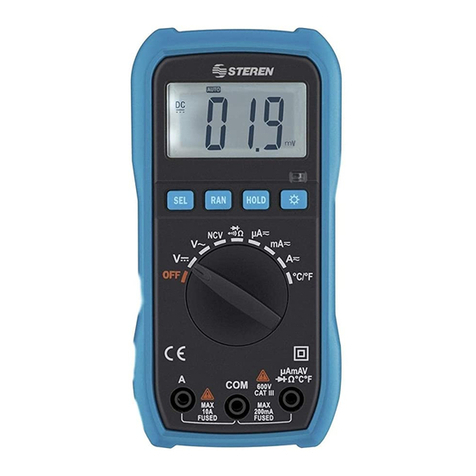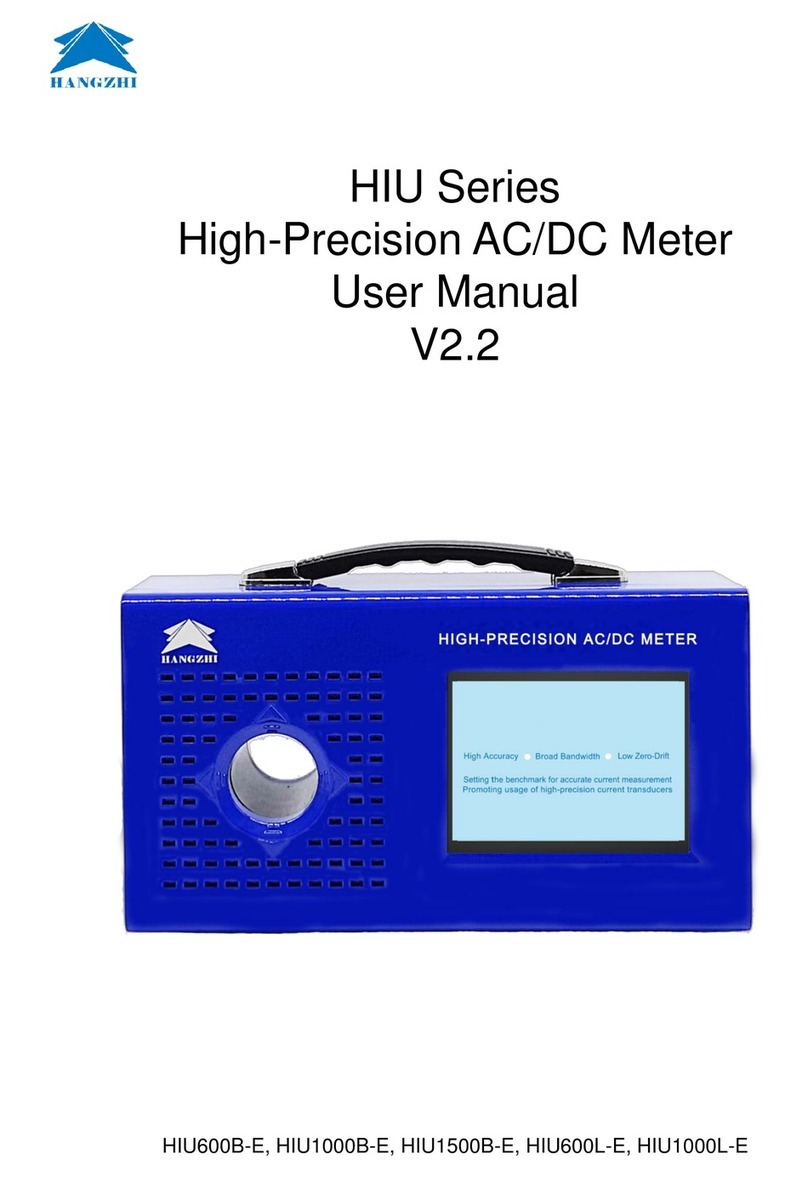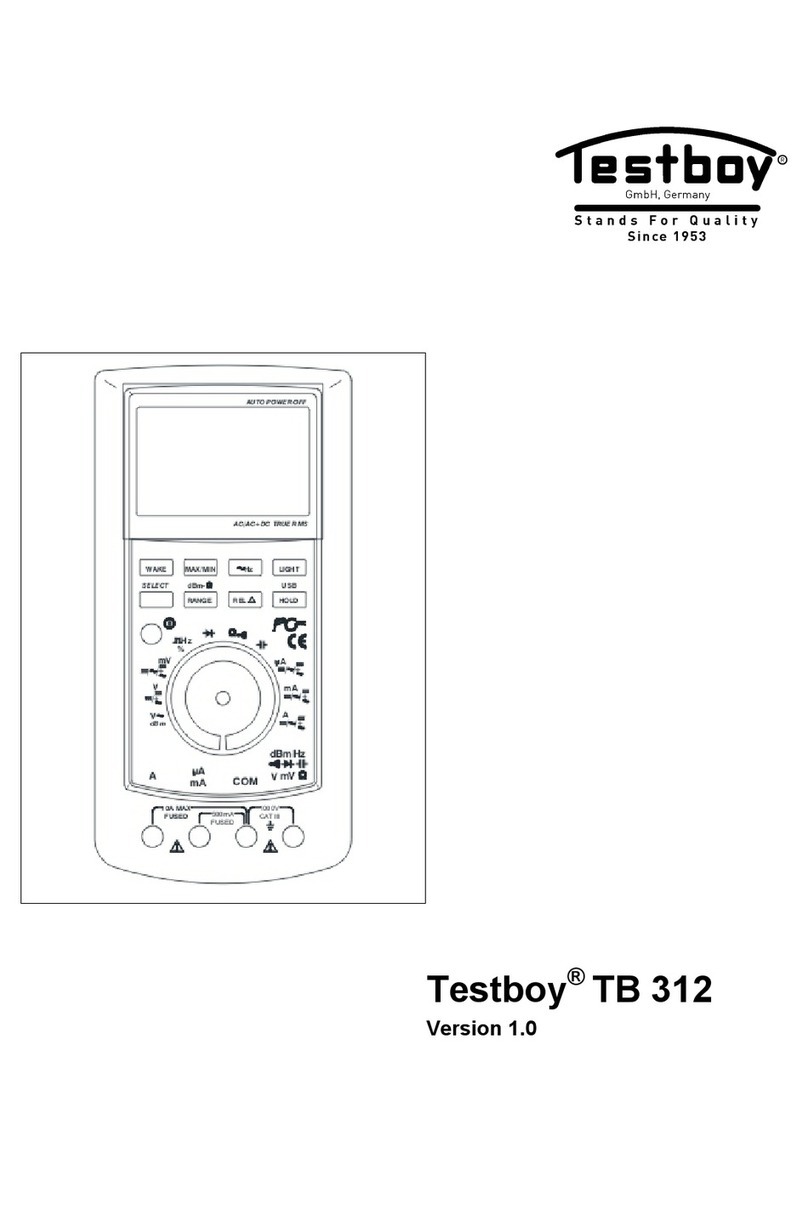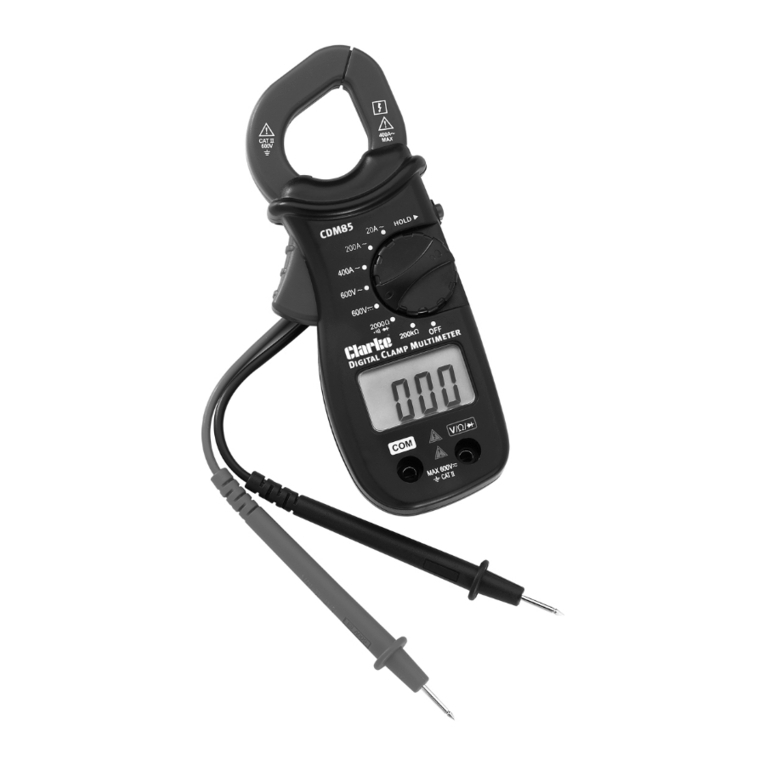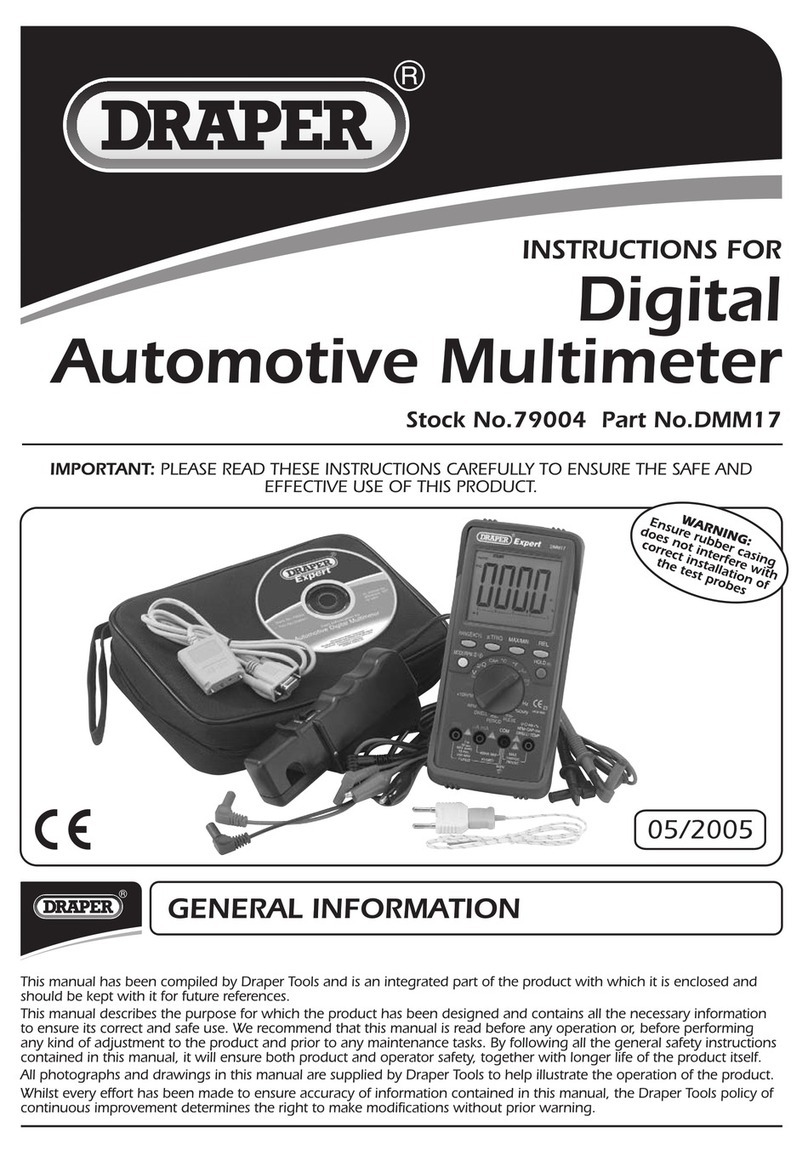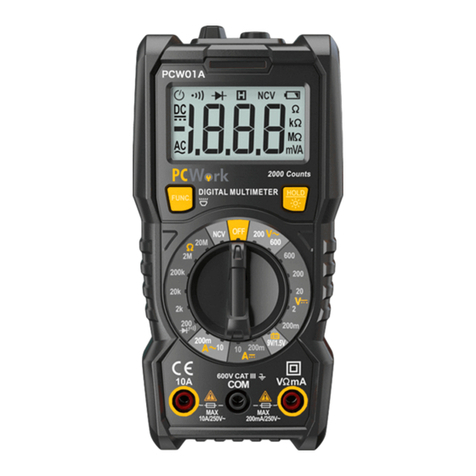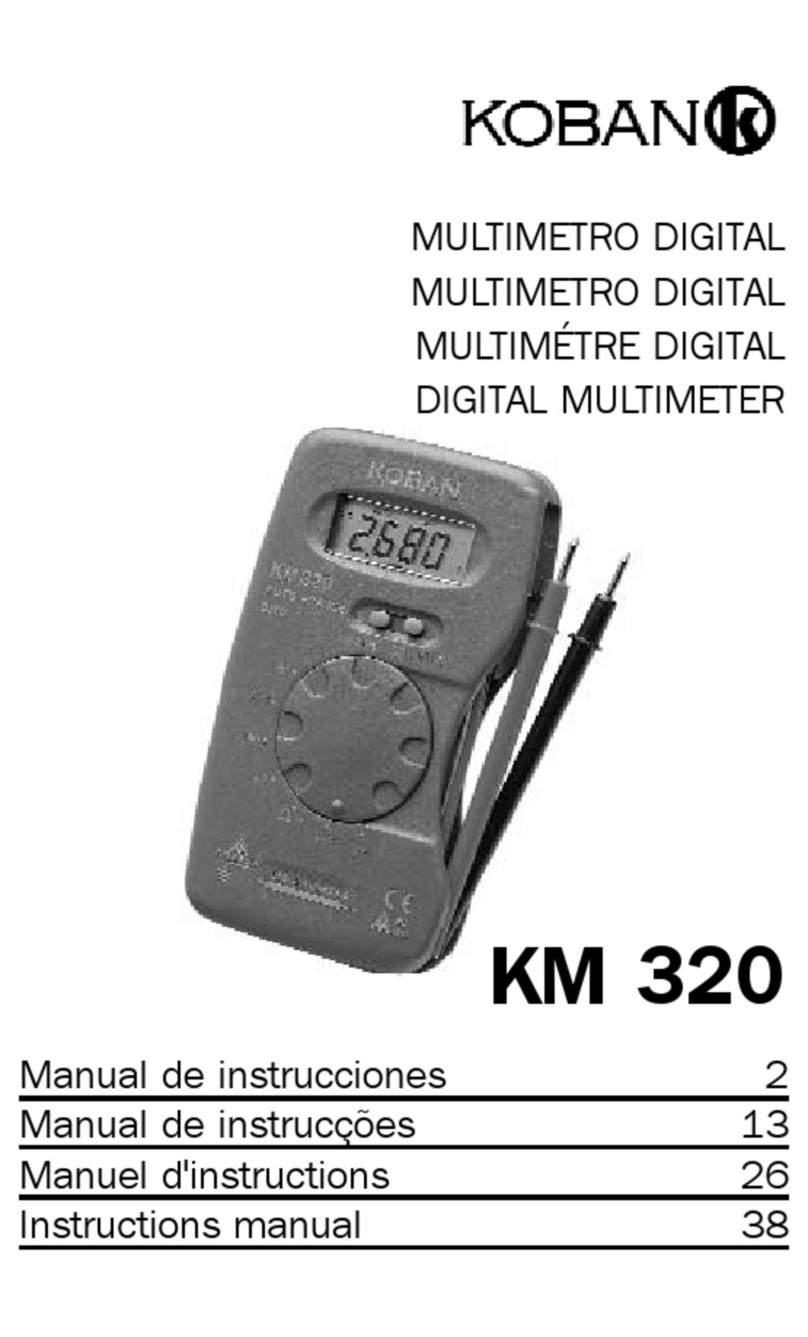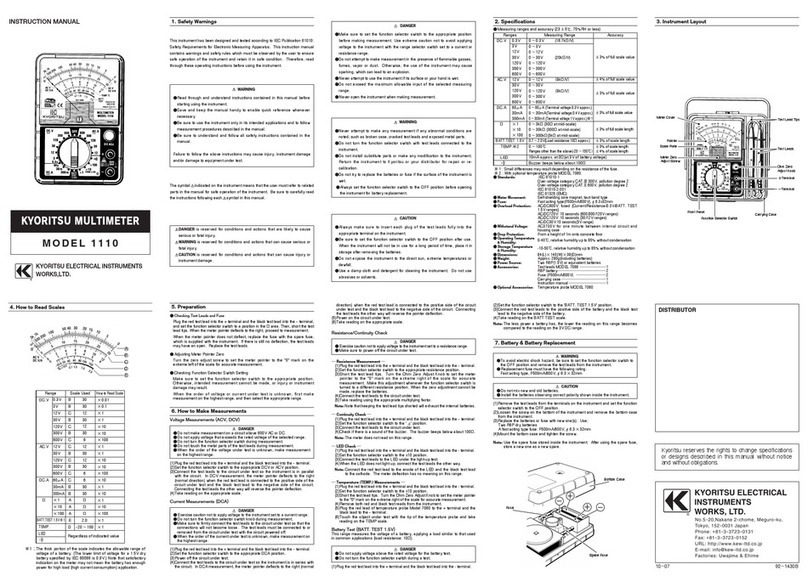Dilog DL9206 User manual

DL9206 AUTORANGING
MULTIMETER
operating manual
EN
61010-1
CAT III
600V

Safety Information
This manual contains information that must be
followed for operating the meter safely and
maintaining the meter in a safe operating condition.
If this meter is not used in the manner specified, the
protection provided may be impaired.
Warning! Warns of potential danger, refer to the
instruction manual to avoid personal injury or
damage to the meter.
Caution! Dangerous voltage. Danger of electrical
shock.
Continuous double or reinforced insulation
complies with IEC536, class II.
Symbol of conformity, confirms conformity with
relevant EU directives. The meter complies with
EMC directives (89/336/EEC). Specifically stand-
ards EN 50081-1 and EN 50082-1 as well as the
Low Voltage Directive (73/23/EEC) described in
the standard EN 61010-1.

Safety Information
The meter has been designed in accordance with
the safety regulations for electronic measuring
instruments, EN 61010-1, IEC 61010.
Voltages above 75V DC or 50V AC may constitute a
serious shock hazard.
Before using the meter check for physical damage to
the casing in particular around the connectors. If the
case is damaged do not use the meter.
Check the test leads for damaged insulation or
exposed metal. Check the leads for continuity.
Replace damaged leads with identical model or
specification before using the meter.
Where applicable use GS38 approved leads (not
supplied) these are available from Di-Log. When using
test leads keep fingers behind the finger guards.
Do not apply more than the rated voltage, as marked
on the meter between the terminals or between any
terminal and ground.

Safety Information
Before making a measurement ensure that the rotary
switch is set to the appropriate range. Do not turn the
rotary switch whilst making a measurement.
Use the appropriate terminals, function and range for
your measurements. If the value to be measured is
not known use the maximum measurement position
and reduce the range step by step until a satisfactory
reading is obtained.
Do not use or store the meter in an environment of
high temperature, humidity, fumes, vapour, gaseous,
inflammable and strong magnetic field. The perform-
ance and safety of the use may be compromised in
such circumstances.
Disconnect circuit power and discharge all high
voltage capacitors before testing resistance,
continuity, diodes, capacitance or current.
Before measuring current check the meters fuses and
turn off power to the circuit before connecting the
meter to the circuit.

Safety Information
Replace the battery as soon as the low battery
indicator appears. If the battery is low the meter
may give false readings.
Turn the meter power off when not in use,. Remove
the battery if the meter is in use for a long period.
Constantly check the battery as it may have leaked.
A leaking battery will damage the meter.
The meter may only be opened by a qualified service
technician for calibration and repair.

Input Limits
Symbols and Annunciators
Continuity
BAT Low Battery
Diode
HOLD Data Hold
AUTO AutoRanging
AC Alternating Current or Voltage
DC Direct Current or Voltage
Never apply voltage or current to the meter that exceeds
the specified maximum:
Function Maximum
V DC or V AC 1000V DC, 750V AC
A DC/AC 10A DC/AC
(30 seconds max every 15 minutes)
Frequency, Resistance, 250V DC/AC
Capacitance, Duty Cycle,
Diode test, Continuity
Temperature 250V DC/AC

1. 6000 count Liquid Crystal Display with symbolic signs.
2. Function rotary switch.
3. 10A (positive) input terminal for 10A DC or AC
measurements.
4. COM (negative) input terminal.
5. Positive input terminal.
6. HOLD pushbutton.
7. Max/Min pushbutton.
8. Range/ Diode pushbutton.
9. Hz/Duty pushbutton.
Controls and Inputs
1
2
3
8
9
5
6
7
4

Specifications
The instrument complies with: EN61010-1.
Insulation: Class2, Double insulation.
Overvoltage category: CATIII 600V.
Display:
6000 counts LCD display with function indication.
Polarity: Automatic, (-) negative polarity indication.
Overrange: “OL” mark indication.
Low battery indication: The “BAT” is displayed when
the battery voltage drops below the operating level.
Measurement rate: 2 times per second, nominal.
Auto power off: Meter automatically shuts down after
approx. 15 minutes of inactivity.
Operating environment: 0˚C to 50˚C (32˚F to 122
˚F) at < 70 % relative humidity.
Storage temperature: -20˚C to 60˚C (-4˚F to 140˚F)
at < 80 % relative humidity.
For inside use, max height: 2000m
Pollution degree: 2
Power: One 9V battery , NEDA 1604, IEC 6F22.
Dimensions: 150 (H) x 70 (W) x 48 (D) mm
Weight: Approx.: 255g.
Accuracy is given at 18˚C to 28˚C (65˚F to 83˚F), less than 70 % RH

Specifications
DC Current (Auto-ranging for uA and mA)
Range Resolution Accuracy
10A 1mA ±2.5% of rdg + 5 dgts
Overload Protection: 10A / 250V Fuse.
Maximum Input: 10A dc or ac rms on 10A DC range..
DC Voltage
Range Resolution Accuracy
600.0mV 0.1mV ±0.5% of rdg + 2 dgts
6.000V 1mV
60.00V 10mV ±1.2% of rdg + 2 dgts
600.0V 100mV
1000V 1V ±1.5% of rdg + 2 dgts
Input Impedance: 7.8MΩ.
Maximum Input: 1000V dc or 750V ac rms.
AC Current (Auto-ranging for uA and mA)
Range Resolution Accuracy
10A 1mA ±3.0% of rdg + 7 dgts
Overload Protection: 10A / 250V Fuse.
Frequency Range: 50 to 60 Hz.
Maximum Input: 10A dc or ac rms on 10A AC range.
AC Voltage
Range Resolution Accuracy
6.000V 1mV +1.2% of rdg + 3 dgts
60.00V 10mV +1.5% of rdg + 3 dgts
600.0V 100mV
750V 1V +2.0% of rdg + 4 dgts
Input Impedance: 7.8MΩ.
Frequency Range: 50 to 60Hz .
Maximum Input: 1000V dc or 750V ac rms..

Specifications
Resistance (Auto-ranging)
Range Resolution Accuracy
600.0Ω 0.1Ω ±1.2% of rdg + 4 dgts
6.000kΩ 1Ω ±1.0% of rdg + 2 dgts
60.00kΩ 10Ω ±1.2% of rdg + 2 dgts
600.0kΩ 100Ω
6.000MΩ 1kΩ
60.00MΩ 10kΩ ±2.0% of rdg + 3 dgts
Input Protection: 250V dc or 250V ac rms.
Capacitance (Auto-ranging)
Range Resolution Accuracy
40.00nF 10pF ±5.0% of rdg + 7 dgts
400.0nF 0.1nF
4.000uF 1nF ±3.0% of rdg + 5 dgts
40.00uF 10nF
400.0uF 0.1uF ±5.0% of rdg + 5 dgts
4000uF 1uF ±5.0% of rdg + 5 dgts
Input Protection: 250V dc or 250V ac rms.
Frequency (Auto-ranging)
Range Resolution Accuracy
6.999Hz 0.001Hz
69.99Hz 0.01Hz ±1.5% of rdg + 5 dgts
699.9Hz 0.1Hz
6.999kHz 1Hz
69.99kHz 10Hz ±1.2% of rdg + 3 dgts
699.9kHz 100Hz
2.999MHz 1kHz ±1.5% of rdg + 4 dgts
Sensitivity: >0.5V RMS while ≤ 1MHz ;
Sensitivity: >3V RMS while >1MHz ;
Overload protection: 250V dc or ac rms.

Specifications
Duty Cycle
Range Resolution Accuracy
0.1%~99.9% 0.1% ±1.2% of rdg + 2 dgts
Pulse width: >100us, <100ms; Frequency width: 5Hz – 150kHz
Sensitivity: >0.5V RMS Overload protection: 250V dc or ac rms.
Temperature
Range Resolution Accuracy
-20˚C~+760˚C 1˚C ±3% of rdg
-4˚F~+1400˚F 1˚F ±5˚C/9˚F
Sensor: Type K Thermocouple.
Overload protection: 250V dc or ac rms.
Audible continuity
Audible threshold: Less than 30Ω;
Test current: <0.3mA
Overload protection: 250V dc or ac rms.
Diode Test
Range Resolution Accuracy
0.3mA typical 1 mV ±10% of rdg + 5 dgts
Open circuit voltage: 1.5V dc typical.
Overload protection: 250V dc or ac rms.

Operation
Warning:
RISK OF ELECTROCUTION. HIGH-VOLTAGE CIRCUITS,
BOTH AC AND DC, ARE VERY DANGEROUS AND
SHOULD BE MEASURED WITH GREAT CARE.
1. ALWAYS turn the function switch to the OFF
position when the meter is not in use. This meter
has Auto OFF that automatically shuts the meter
OFF if 15 minutes elapse between uses.
2. If “OL” appears in the display during a
measurement, the value exceeds the range you
have selected. Change to a higher range.
Note:
On some low AC and DC voltage ranges, with the
test leads not connected to a device, the display
may show a random, changing reading. This is
normal and is caused by the high-input sensitivity.
The reading will stabilize and give a proper
measurement when connected to a circuit.

Operation
Range Button
When the meter is first turned on, it automatically
goes into AutoRanging. This automatically selects the
best range for the measurements being made and
is generally the best mode for most measurements.
For measurement situations requiring that a range be
manually selected, perform the following:
1. Press the RANGE button. The “AUTO” display
indicator will turn off.
2. Press the RANGE button to step through the
available ranges until you select the range
you want.
3. Press and hold the RANGE button for 2 seconds
to exit the Manual Ranging mode and return to
AutoRanging.(If backlight is turn on, please
press BACKLIGHT button it will turn off).
4. To select Diode/continuity.
Data Hold Button
The Hold function allows the meter to “freeze” a
measurement for later reference.
1. Press the HOLD button to “freeze” the reading on
the indicator. The indicator “HOLD” will be appear
in the display.
2. Press the HOLD button to return to normal
operation.

Operation
Hz/duty
1. Switch to Hz/Duty range.
2. Press the Hz/Duty button to show the reading
in the display and the “Hz/Duty” indicator will
appear on the display.

DC Voltage Measurements
Caution:
DO NOT MEASURE DC VOLTAGES IF A MOTOR ON
THE CIRCUIT IS BEING SWITCHED ON OR OFF.
LARGE VOLTAGE SURGES MAY OCCUR THAT
CAN DAMAGE THE METER.
1. Set the function switch to the V DC position .
2. Insert the black test lead banana plug into the
negative (COM) terminal and the red test lead
banana plug into the positive (V) terminal.
3. Connect the test probe tips to the circuit under
test. Be sure to observe the correct polarity (red
lead to positive, black lead to negative).
4. Read the voltage in the display. The display will
indicate the proper decimal point and value. If
the polarity is reversed, the display will show (-)
minus before the value.

AC Voltage Measurements
Warning:
RISK OF ELECTROCUTION. THE PROBE TIPS MAY NOT
BE LONG ENOUGH TO CONTACT THE LIVE PARTS IN-
SIDE SOME 240V OUTLETS FOR APPLIANCES BECAUSE
THE CONTACTS ARE RECESSED DEEP IN THE OUTLETS.
AS A RESULT, THE READING MAY SHOW 0 VOLTS WHEN
THE OUTLET ACTUALLY HAS VOLTAGE ON IT. MAKE
SURE THE PROBE TIPS ARE TOUCHING THE METAL
CONTACTS INSIDE THE OUTLET BEFORE ASSUMING
THAT NO VOLTAGE IS PRESENT.
Caution:
DO NOT MEASURE AC VOLTAGES IF A MOTOR ON
THE CIRCUIT IS BEING SWITCHED ON OR OFF.
LARGE VOLTAGE SURGES MAY OCCUR THAT CAN
DAMAGE THE METER.
1. Set the function switch to the V AC position.
2. Insert the black test lead banana plug into the
negative (COM) terminal and the red test lead
banana plug into the positive (V) terminal.
3. Connect the test probe tips to the circuit
under test.
4. Read the voltage in the display. The display will
indicate the proper decimal point, value and
symbol (AC, V, etc.).

DC Current Measurements
Caution:
DO NOT MAKE CURRENT MEASUREMENTS ON
THE 10A SCALE FOR LONGER THAN 30 SECONDS.
EXCEEDING 30 SECONDS MAY CAUSE DAMAGE TO
THE METER AND/OR THE TEST LEADS.
1. Insert the black test lead banana plug into the
negative (COM) terminal.
2. For DC current measurements , set the function
switch to the DC 10A position and insert the red
test lead banana plug into the 10A terminal.
3. Remove power from the circuit under test, then
open up the circuit at the point where you wish
to measure current.
4. Connect the black test probe tip to the
negative side of the circuit. Connect the red test
probe tip to the positive side of the circuit.
5. Apply power to the circuit.
6. Read the current in the display. The display
will indicate the proper decimal point, value
and symbol.

AC Current Measurements
Warning:
TO AVOID ELECTRIC SHOCK, DO NOT MEASURE
AC CURRENT ON ANY CIRCUIT WHOSE VOLTAGE
EXCEEDS 250V AC.
Caution:
DO NOT MAKE CURRENT MEASUREMENTS ON THE 10A
SCALE FOR LONGER THAN 30 SECONDS. EXCEEDING 30
SECONDS MAY CAUSE DAMAGE TO THE METER AND/OR
THE TEST LEADS.
1. Insert the black test lead banana plug into the
negative (COM) terminal.
2. For AC current measurements , set the function
switch to the AC 10A position and insert the red test
lead banana plug into the 10A terminal.
3. Remove power from the circuit under test, then
open up the circuit at the point where you wish to
measure current.
4. Connect the black test probe tip to the negative side
of the circuit. And connect the red test probe tip to
the positive side of the circuit.
5. Apply power to the circuit.
6. Read the current in the display. The display will
indicate the proper decimal point, value and symbol.

Resistance Measurements
Warning:
TO AVOID ELECTRIC SHOCK, DISCONNECT POWER
TO THE UNIT UNDER TEST AND DISCHARGE ALL
CAPACITORS BEFORE TAKING ANY RESISTANCE
MEASUREMENTS. REMOVE THE BATTERIES AND
UNPLUG THE LINE CORDS.
1. Set the function switch to the Ωposition.
2. Insert the black test lead banana plug into the
negative (COM) terminal and the red test lead
banana plug into the positive Ωterminal.
3. Connect the test probe tips across the circuit or
part under test. It is best to disconnect one side of
the part under test so the rest of the circuit will not
interfere with the resistance reading.
4. Read the resistance in the display. The display will
indicate the proper decimal point, value and symbol.

Continuity Check
Warning:
TO AVOID ELECTRIC SHOCK, NEVER MEASURE
CONTINUITY ON CIRCUITS OR WIRES THAT HAVE
VOLTAGE ON THEM.
1. Set the function switch to the position.
2. Insert the black lead banana plug into the negative
(-) terminal (COM) and the red test lead banana
plug into the positive (+) terminal (Ω).
3. Press the button until the symbol appears in
the display.
4. Connect the test probe tips to the circuit or wire you
wish to check.
5. If the resistance is less than approximately 30Ω, the
audible signal will sound. The display will also show
the actual resistance.
Table of contents
Other Dilog Multimeter manuals
